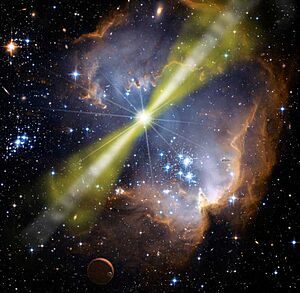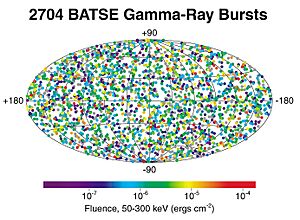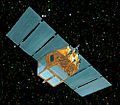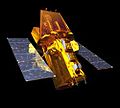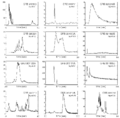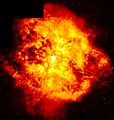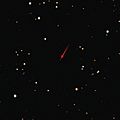Gamma-ray burst facts for kids
Imagine the biggest, brightest explosions in the universe! Those are called Gamma-ray bursts (or GRBs). They are super powerful flashes of gamma rays. We see them happening in faraway galaxies. They're the brightest light shows we know of in the whole universe!
These bursts can last from tiny fractions of a second to several minutes, but usually, they're over in just a few seconds. After the main flash, there's often a longer-lasting 'afterglow.' This glow can be seen in different types of light, like X-rays, ultraviolet light, visible light, infrared, and radio waves.
Most GRBs happen when a giant, fast-spinning star runs out of fuel and collapses. This collapse forms a black hole and shoots out a narrow beam of intense radiation. Another type of GRB, called 'short' bursts, might come from two neutron stars crashing into each other.
The places where most GRBs happen are billions of light years away from Earth. This means these explosions are incredibly powerful! A typical burst releases as much energy in a few seconds as our Sun will make in its entire 10 billion year lifetime. Luckily, they are very rare, happening only a few times per galaxy every million years.
All the GRBs we've seen have come from outside our own Milky Way galaxy. There are similar events, called soft gamma repeater flares, that happen closer to home from special stars called magnetars. Some scientists think a gamma-ray burst in our galaxy could cause a huge extinction event on Earth. But so far, we haven't found any evidence of this happening.
History
Gamma-ray bursts were first discovered by accident in the late 1960s. The U.S. Vela satellites were originally built to detect gamma radiation from nuclear weapons tested in space.
On July 2, 1967, a satellite named Vela 4 and another called Vela 3 picked up a flash of gamma radiation. It didn't look like any nuclear weapon explosion they knew of. The team at the Los Alamos Scientific Laboratory wasn't sure what it was, so they saved the data to study later.
By looking at when the bursts arrived at different satellites, the team could figure out where sixteen of these bursts came from in the sky. They were sure the bursts were not from Earth or the Sun. This amazing discovery was finally shared with the public in 1973.
Long Gamma-Ray Bursts
Most GRBs we observe last longer than two seconds. These are called long gamma-ray bursts. Scientists have studied them much more than the shorter ones. Almost every long gamma-ray burst that has been well-studied has been linked to a galaxy where many stars are forming. Many have also been connected to a special kind of supernova called a core-collapse supernova. This strongly suggests that long GRBs happen when very massive stars die. When we look at the afterglow of distant long GRBs, it also tells us they come from areas where new stars are being born. This is because looking at distant galaxies is like looking back in time to when galaxies were younger.
How Powerful Are They?
Scientists believe that gamma-ray bursts are highly focused explosions. Most of their energy shoots out in a narrow, super-fast jet. This jet travels at speeds over 99.995% of the speed of light!
We can estimate how wide this jet is by watching how the afterglow changes. After a while, the slowly fading afterglow suddenly gets much dimmer. This happens when the jet slows down and can no longer focus its radiation as well. Observations show that the jet angle can vary quite a bit, from about 2 to 20 degrees wide.
Because their energy is so strongly focused into a narrow beam, most gamma rays from these bursts miss Earth and are never detected. But when a gamma-ray burst is pointed right at Earth, the focused energy makes it look much brighter than it would if its energy spread out in all directions. When we account for this focusing effect, a typical gamma-ray burst releases about 1044 J of energy. That's like 1/2000 of the energy equivalent of a Solar mass!
This amount of energy is similar to what's released in a very bright type Ib/c supernova, sometimes called a 'hypernova'. Very bright supernovae have been seen in the same spot as some of the closest GRBs.
Images for kids
-
Artist's illustration showing the life of a massive star as nuclear fusion converts lighter elements into heavier ones. When fusion no longer generates enough pressure to counteract gravity, the star rapidly collapses to form a black hole. Theoretically, energy may be released during the collapse along the axis of rotation to form a GRB.
-
NASA's Swift Spacecraft launched in November 2004
-
Hubble Space Telescope captures infrared glow of a kilonova blast.
-
Hubble Space Telescope image of Wolf–Rayet star WR 124 and its surrounding nebula. Wolf–Rayet stars are candidates for being progenitors of long-duration GRBs.
See also
 In Spanish: Brote de rayos gamma para niños
In Spanish: Brote de rayos gamma para niños


